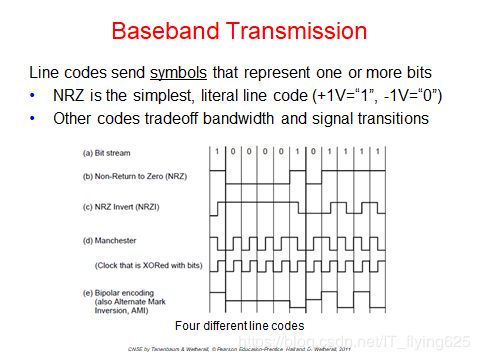The Physical Layer(Computer networks)
Computer networks——The Physical Layer
•Theoretical Basis for Data Communications
•Guided Transmission Media
•Wireless Transmission
•Communication Satellites
•Digital Modulation and Multiplexing
•Public Switched Telephone Network
•Mobile Telephone System
•Cable Television
Guided Transmission (Wires & Fiber)
Media have different properties, hence performance
•Reality check
−Storage media »
•Wires:
−Twisted pairs »
−Coaxial cable »
−Power lines »
•Fiber cables »
STP:屏蔽双绞线
UTP:非屏蔽双绞线
This is the garden variety cable used in most offices, e.g., as gigabit Ethernet cables. It is also the old-fashioned telephone line that reaches into your home. The twists reduce interference because the signal radiated from the wire at one location is largely canceled by the signal from the nearby twist; tighter twisting gives higher quality wires. UTP = unshielded twisted pair. STP = shielded twisted pair does exist to shield the wire from external noise for more demanding uses (higher data rates) but is it more expensive and difficult to work with.
Full-duplex link 全双工
•Used for transmission in both directions at once 双向同时使用
•e.g., use different twisted pairs for each direction
Half-duplex link 半双工
•Both directions, but not at the same time 可以双向使用但一次只能使用一个方向的链路
•e.g., senders take turns on a wireless channel
Simplex link 单双工
•Only one fixed direction at all times; not common 只允许一个方向传输的链路
Wires – Coaxial Cable (“Co-ax”) 同轴电缆
A higher quality cable than UTP that can carry data at higher rates for longer distances, but is usually more expensive. Enclosing one wire within another provides better immunity to electrical noise. Commonly used for video, e.g., cable TV, because it needs larger bandwidth.
Wires – Power Lines
It is horrible because it carries power signals at the same time and the wiring was not designed for data communications, e.g., it is not tightly twisted like twisted pair, and its electrical properties change as devices that are plugged in turn on and off. But it is convenient because it is already installed and many devices are plugged in to get power, so people are starting to use it.
Fiber Cables
The other main kind of guided media is optical fiber. It is widely used for links that run at high rates, particularly over long distances. It is much, much better than wire in both regards. Examples include the backbone links between ISP facilities, and fiber runs to the home (FTTH) that provide much higher bandwidth home connectivity than ADSL. The optical fiber is a very long, thin strand of glass. The figure shows the overall system. A light source is needed to produce pulses of light, either a LED or a laser (better quality, more expensive). The pulses of light are trapped in the fiber (total internal reflection) and follow it. At the other end a photodetector turns pulses of light into electrical signals.
This slide shows why fiber runs for high rates and long distances – attenuation is very low (can go 10km before the signal has lost 3dB or half its power) for enormous regions of bandwidth (30 *Terahertz* when wavelength is converted to frequency).
Comparison of the properties of wires and fiber:
| Property |
Wires |
Fiber |
| Distance |
Short (100s of m) |
Long (tens of km) |
| Bandwidth |
Moderate |
Very High |
| Cost |
Inexpensive |
Less cheap |
| Convenience |
Easy to use |
Less easy |
| Security |
Easy to tap |
Hard to tap |
Fiber gives you very high rates over long runs; wires score less highly on these properties and support high rates over much shorter runs. But wires are usually the inexpensive solution when the transmission/reception hardware is included. Wires are also easier to work with; fiber requires greater care with connections. Fiber has the advantage that it is very hard to tap as the light is confined only to the fiber or the fiber is broken. Wires are usually easy to tap because they radiate the signal well.
Modulation schemes send bits as signals; multiplexing schemes share a channel among users.
•Baseband Transmission »
•Passband Transmission »
•Frequency Division Multiplexing »
•Time Division Multiplexing »
•Code Division Multiple Access »
友情链接:https://blog.csdn.net/qq_30611601/article/details/81566193















